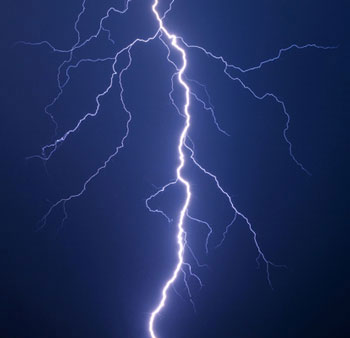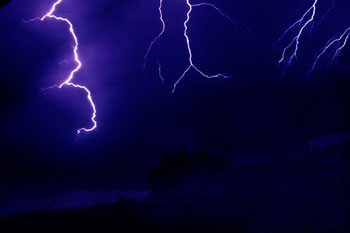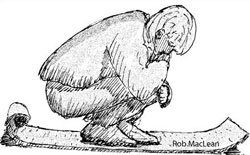This article may include affiliate links. If you click a link and make a purchase, Utah Outdoor Activities may receive a small commission at no extra cost to you. We only recommend products or services we personally use. FTC Affiliate Disclosure.

Thunder and lightning storms are a common occurrence in Utah during the hot summer months. These storms leave people scrambling for cover because many fail to heed the warnings: the big dark clouds in the distance and the sound of thunder roaring through the sky. Many outdoor enthusiasts have taken chances during an afternoon thunderstorm.
You know the classic excuses—just one more cast, the marina is just around the bend, or just a few more minutes while enjoying the view. I mean, why not? The odds of becoming a lightning victim in the United States in any year are 1 in 700,000. But the odds of being struck by lightning in your lifetime are 1 in 3,000 (source: National Geographic. As you can see, the more times you challenge the power of these storms during your life, the better chance you have of becoming a statistic. Speaking of statistics, on average, there are 51 lightning-related deaths in the United States each year (based on a 30-year average).
Between 2006 and 2013, there were 261 reported lightening-related deaths. So far in 2014, there have been 18 reported deaths across the country. Interestingly, 226 of those reported deaths were men and 53 were women.
Even though the odds of being struck by lightning are low, these statistics show that summer thunder and lightning storms are dangerous and should be avoided if possible. Since this article is focused on Utah’s backcountry, there is a good chance you may be caught in one of the state’s wicked thunder and lightning storms while camping, hiking, backpacking, fishing, or enjoying a picnic at a local park. If avoidance is impossible, here are some safety tips and precautions you can take to help decrease your chances of being struck or injured by lightning.
Check the Weather

Before you head out into the outdoors, be sure to check the weather reports. If thunderstorms are likely, plan your day so you are off of any exposed terrain before the storms hit.
Safer Terrain
In Utah’s backcountry, safer terrain can decrease your chances of being struck or injured. During a thunder and lightning storm, you should avoid high terrain and even the terrain around it. Avoid peaks, ridges, and significantly higher ground. If you are exposed to lightening while attempting to get to safer terrain, you should stop and assume the lightning position. Many people have died while walking to safer terrain, but no one has died while in the lighting position.
Wide open ground
Wide open ground such as Utah’s West Desert offers high exposure during an electrical storm. Try to avoid trees and bushes that rise above the others, since the highest objects tend to attract lightning strikes. Before the storm hits, find a depression or ravine and assume the lightning position.
Boaters
If you are boating on any of Utah’s many lakes and reservoirs and you hear thunder, you should immediately start heading for shore. There are many reports of deaths and injuries to boaters caused by lightning. The obvious reason is your boat will always be the tallest object in the water. If you take shelter on shore, be sure to be cautious of trees at the edge of the water because they may be the tallest objects around. If possible, anchor your boat and head to your car or a safe building and wait out the storm.
Trees
As mentioned many times in this article, lone trees should be avoided during electrical storms. They are generally taller than their surroundings and attract strikes. You will have much better odds in a forest setting with many trees, than under one tree in a wide open space.
What Is the Lightning Position?

The lightning position is a safety position that may reduce the chances of suffering a direct strike during an electrical storm. This is for those times when you feel there is no other alternative but to duck for cover. To assume the lightning position, squat, ball up, and keep your feet together. If you have some sort of insulated object such as a sleep pad, place it on the ground first. This will act as an insulating barrier between you and the ground.
The lightning position and the tips above may reduce your chances of a lightning-related injury; however, they are no substitute for getting to safer terrain or a structure if it is immediately available.
If you are out enjoying the spectacular beauty of this great state and find yourself caught in a lightning storm in Utah’s backcountry, remembering these tips may reduce your chances of becoming injured or killed by a lightning strike.
NOLS Backcountry Lighning Safety Guidelines
We hope you enjoyed this information. For more outdoor activities, please connect with us on YouTube, Facebook and Instagram. Help us keep this site up and running by visiting our online store which features outdoor themed gifts, decor and more. Thank you for visiting and for your ongoing support!